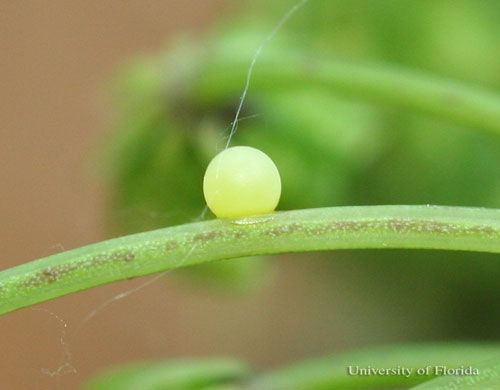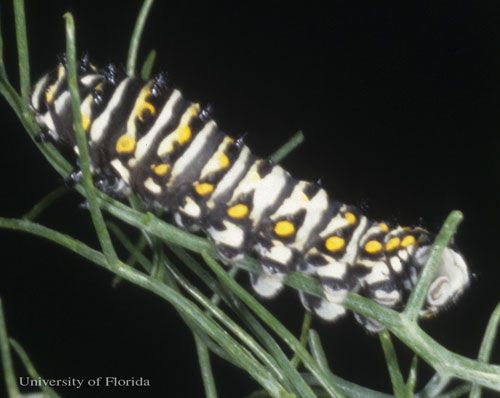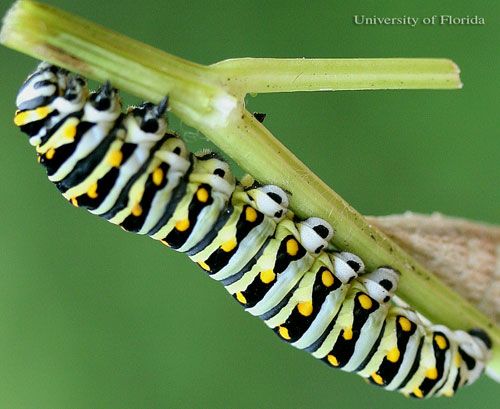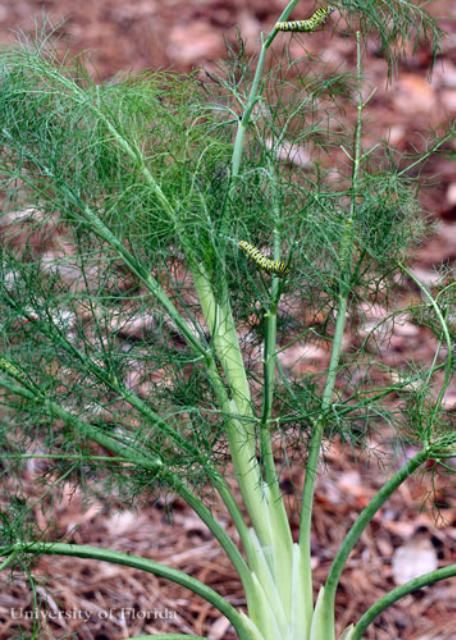The Featured Creatures collection provides in-depth profiles of insects, nematodes, arachnids, and other organisms relevant to Florida. These profiles are intended for the use of interested laypersons with some knowledge of biology as well as academic audiences.
Introduction
The eastern black swallowtail is one of our most common and most studied swallowtails. Although it is admired for its beauty, it is one of the very few butterflies that may occasionally be considered a pest. It has been known by a variety of other names including black swallowtail, American swallowtail, parsnip swallowtail, parsley swallowtail, celeryworm, and caraway worm (Miller 1992). Several subspecies of Papilio polyxenes occur in Mexico, Central America and South America (Minno & Emmel 1993). Only the subspecies asterius will be covered here and, for simplicity, will be referred to as the black swallowtail even though technically the name "black swallowtail" also includes the other subspecies.
The genus name "Papilio" is the Latin word for butterfly. The specific epithet "polyxenes" is from Polyxena, the daughter of Priamos, King of Troy (Homer's Iliad) (Opler & Krizek 1984).

Credit: Donald Hall, University of Florida
Distribution
The black swallowtail is found throughout southern Canada, most of the eastern and mid-western United States west to the Rocky Mountains, and southwest into Arizona and northern Mexico. It is rare in the Florida Keys, apparently due to the absence of its carrot family (Apiaceae) hosts (Minno & Emmel 1993).
Description
Adults
The adult wing spread range is 6.9–8.4 cm (Minno & Minno 1999) with females typically larger than males. The upper surfaces of the wings display sexual dimorphism. The upper surface of the wings is black with two rows of yellow spots—large and bright in males and smaller and lighter in females. The area between the rows of spots on the hind wings of females is powdery iridescent blue. The blue area in males is much less prominent. There is a conspicuous red spot with a black bull's-eye on the inner-hind margin of the hind wings and an isolated yellow spot on the costa of the front wings.
The under sides of wings of males and females are virtually identical. The front wings have two rows of pale yellow spots. Hind wings have rows of bright orange spots separated by areas of powdery blue.

Credit: Donald Hall, University of Florida

Credit: Donald Hall, University of Florida

Credit: Donald Hall, University of Florida
Eggs
The eggs are pale yellow and are laid on the host plants.

Credit: Donald Hall, University of Florida
Larvae
Young larvae are mostly black with a white saddle. The white saddle is due to uric acid deposits that may function as an antioxidant to protect larvae from phototoxic chemicals in the diet (Timmerman & Berenbaum 1999). Older larvae are green with black transverse bands containing yellow spots.

Credit: Jerry Butler, University of Florida

Credit: Jerry Butler, University of Florida

Credit: Jerry Butler, University of Florida

Credit: Donald Hall, University of Florida
Pupae
Larvae pupate in the typical swallowtail "head-up" position attached at the posterior end to a silk pad by the Velcro®-like cremaster and supported by a silk girdle. Pupae of the overwintering generation (short photoperiod pupae) are brown, but those of other generations may be either green with yellow markings or brown depending on the pupation substrate (Scott 1986, Hazel & West 1979).

Credit: Donald Hall, University of Florida

Credit: Donald Hall, University of Florida

Credit: Donald Hall, University of Florida
Life Cycle
Habitats of the black swallowtail are generally open areas, including both uplands and wet areas—wet prairies, fields, flat-woods, pine savannas, roadsides, weedy areas, and gardens (Minno et al. 2005). Males perch and patrol open areas for females—often near patches of a host plant (Glassberg et al. 2000).
Eggs are laid singly on the host plants—usually on new foliage and occasionally on flowers. Development time is variable depending on temperature and host plant species, but generally the egg stage lasts four to nine days, the larval stage 10–30 days, and the pupal stage nine to 18 days (except for overwintering pupae). Pupae are the overwintering stage. There are two generations in northern parts of the range but at least three generations in the South (Minno et al. 2005, Opler & Krizek 1984).
Carter and Feeny (1986) reported on a method for maintaining a colony of black swallowtails in the laboratory with hand-pairing of adults.
Natural Enemies
In addition to the generalist predators that prey on Lepidoptera larvae, there are at least three tachinid fly parasitoids and at least five hymenopterous parasitoids listed from Papilio polyxenes larvae.
Defenses
Young larvae are bird-dropping mimics. The brindled color pattern of older larvae likely makes them cryptic while resting on the sun-dappled host plants. Pupal colors match the substrate and are cryptic.
The poisonous and distasteful pipevine swallowtail, Battus philenor (L.), is the model for a complex of black-colored Batesian mimic butterflies including the black swallowtail. The ventral wing coloration of both male and female black swallowtails is mimetic (Codella & Lederhouse 1989), but only the female is a convincing mimic when the wings are spread (Lederhouse 1995). The conspicuous yellow on the upper wings of males, which renders males relatively non-mimetic, likely functions in male-male territorial interactions (Lederhouse 1982). Both sexes spend much of their time roosting with the wings closed which maximizes the protective effects of mimicry against vertebrate predators.
All swallowtail larvae have eversible horn-like organs behind the head known as osmeteria. The osmeterium of the black swallowtail is bright yellow-orange. When threatened, larvae rear up, extrude the osmeterium, and attempt to smear the potential predator with a chemical repellent. The osmeterial repellent is effective against ants (Eisner & Meinwald 1965), but Berenbaum et al. (1992) reported that soldier bugs could attack and eat larvae without evoking extrusion of the osmeteria.
Some insect parasitoids locate their hosts by volatile chemicals in the feces (Vinson 1984). Black swallowtail larvae, like those of some other swallowtail species, throw their fecal pellets with the mandibles (Lederhouse 1990).

Credit: Jerry Butler, UF/IFAS
Hosts
Black swallowtail caterpillars utilize a variety of herbs in the carrot family (Apiaceae) as host plants, including:
native species
- mock bishopweed, Ptilimnium capillaceum (Michx.) Raf.
- roughfruit scaleseed, Spermolepis divaricata (Walter) Raf.
- spotted water hemlock, Cicuta maculata L.
- water cowbane, Oxypolis filiformis (Walter) Britton
- wedgeleaf eryngo, Eryngium cuneifolium (Small)
introduced species
- poison hemlock, Conium maculatum L.
- Queen Anne's lace, Daucus carota L.
- wild parsnip, Pastinaca sativa L.
They will also eat a variety of cultivated herb Apiaceae, including:
- caraway, Carum carvi L.
- celery, Apium graveolens L. var. dulce (Mill.) DC.
- dill, Anethum graveolens L.
- parsley, Petroselinum crispum (Mill.) Nyman ex A.W. Hill
- sweet fennel, Foeniculum vulgare Mill.
They will also use common rue, Ruta graveolens L., in the citrus family (Rutaceae).
All plant parts of both spotted water hemlock and poison hemlock and some other wild species are extremely poisonous if eaten and may also cause contact dermatitis. Care should be exercised when handling these plants and they should never be planted as caterpillar hosts. A potion of poison hemlock was used in ancient Greece to execute prisoners and is believed to be the poison taken by Socrates. Black swallowtail caterpillars are able to detoxify the furanocoumarin chemicals (particularly the linear forms) in these and other toxic Apiaceae (Berenbaum 1981).
Plant names are from Wunderlin and Hansen (2003 or 2011) or the USDA PLANTS Database.

Credit: Donald Hall, University of Florida

Credit: Donald Hall, University of Florida

Credit: Donald Hall, University of Florida

Credit: Donald Hall, University of Florida

Credit: Donald Hall, University of Florida

Credit: Donald Hall, University of Florida

Credit: Donald Hall, University of Florida

Credit: Donald Hall, University of Florida

Credit: Donald Hall, University of Florida

Credit: Donald Hall, University of Florida
Economic Importance
Although black swallowtail caterpillars feed on a number of cultivated plants, they are never sufficiently common to cause a problem in commercial agriculture. If control is required in home gardens, hand-picking is recommended. If hand-picking is impractical, either a foliar insecticide or the bacterial insecticide Bacillus thuringiensis provides effective control (Capinera 2001). Also, there are numerous insect predators and also wasp and fly parasitoids of the caterpillars (Capinera 2001) that provide some natural control.
Selected References
Arnaud PH. 1978. A Host-Parasite Catalog of North American Tachinidae (Diptera). United States Department of Agriculture Miscellaneous Publication 1319. Washington, D.C.
Berenbaum MR. 1981. Effects of linear furanocoumarins on an adapted specialist insect (Papilio polyxenes). Ecological Entomology 6: 345-351.
Berenbaum MR, Moreno B, Green E. 1992. Soldier bug predation on swallowtail caterpillars (Lepidoptera: Papilionidae): Circumvention of defensive chemistry. Journal of Insect Behavior 5: 547-553.
Capinera JL. 2001. Handbook of Vegetable Pests. Academic Press. San Diego, California. 729 pp.
Carter M, Feeny P. 1986. Techniques for maintaining a culture of the black swallowtail butterfly, Papilio polyxenes asterius Stoll (Papilionidae). Journal of the Lepidopterists' Society 39: 125-133.
Codella SG, Lederhouse RC. 1989. Intersexual comparison of mimetic protection in the black swallowtail butterfly, Papilio polyxenes: experiments with captive blue jay predators. Evolution 43: 410-420.
Eisner T, Meinwald YC. 1965. Defensive secretion of a caterpillar (Papilio). Science 150: 1733-1735.
Glassberg J, Minno C, Calhoun JV. 2000. Butterflies through Binoculars: Florida. Oxford University Press. New York, New York. 256 pp.
Hazel WN, West DA. 1979. Environmental control of pupal color in swallowtail butterflies (Lepidoptera: Papilionidae) Battus philenor (L.) and Papilio polyxenes Fabr. Ecological Entomology 4: 393-400.
Krombein KV, Hurd Jr. PD, Smith DR, Burks BD. 1979. Catalog of Hymenoptera in America North of Mexico. Volume 1. Symphyta and Apocrita (Parasitica). Smithsonian Institution Press. Washington, D.C. 1198 pp.
Lederhouse RC. 1990. Avoiding the hunt: Primary defenses of lepidopteran caterpillars. In Evans DL, Schmidt JO. (editors). Insect Defenses. State University of New York Press. Albany, NY. pp. 175-189.
Lederhouse RC. 1982. Territorial defense and lek behavior of the black swallowtail butterfly, Papilio polyxenes. Behavioral Ecology and Sociobiology 10: 109-118.
Lederhouse RC. 1995. Comparative mating behavior and sexual selection in North American Butterflies. In Scriber JM, Tsubaki Y, Lederhouse RC (editors). Swallowtail Butterflies: Their Ecology and Evolutionary Biology. Scientific Publishers, Inc. Gainesville, FL.
Miller JY. (editor). 1992. The Common Names of North American Butterflies. Smithsonian Institution Press. Washington, D.C. 177 pp.
Minno MC, Butler JF, Hall DW. 2005. Florida Butterfly Caterpillars and their Host Plants. University Press of Florida. Gainesville, Florida. 341 pp.
Minno MC, Emmel TC. 1993. Butterflies of the Florida Keys. Scientific Publishers, Gainesville. 168 pp.
NABA. (September 2004). Checklist of North American Butterflies Occurring North of Mexico. North American Butterfly Association.
Opler PA, Krizek GO. 1984. Butterflies East of the Great Plains. The Johns Hopkins University Press. Baltimore, Maryland. 294 pp.
Scott JA. 1986. The Butterflies of North America: A Natural History and Field Guide. Stanford University Press. Stanford, California. 583 pp.
Timmerman S, Berenbaum MR. 1999. Uric acid deposition in larva integument of black swallowtails and speculation on its possible functions. Journal of the Lepidopterists' Society 53: 104-107.
USDA. (September 2011). The PLANTS Database. National Resources Conservation Service. (14 September 2011).
Vinson SB. 1984. Parasitoid-host relationships. In Bell SJ, Carde RT. (editors). Chemical Ecology. Chapman and Hall, London. pp. 205-233.
Wunderlin RP, Hansen BF. 2003. Guide to the Vascular Plants of Florida. 2nd ed. University Press of Florida. Gainesville, Florida. 787 pp.
Wunderlin RP, Hansen BF. (September 2011). Atlas of Florida Vascular Plants. plantatlas.org. https://plantatlas.usf.edu/ (14 September 2011).